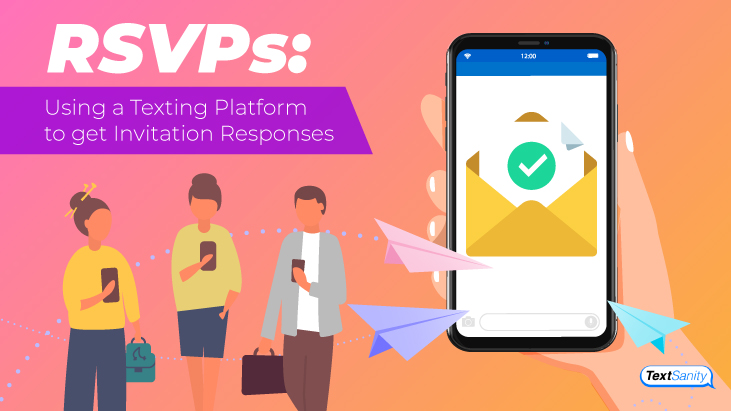RSVPs: Using a Texting Platform to Get Invitation Responses
Updated 11/4/2022
“Repondez s’il vous plait,” “Reply if you please,” or “Please respond” is a traditional request. Most frequently used as an abbreviation (RSVP), an RSVP requests a guest to inform the host of their attendance.
The host typically follows up a response with important information, such as event details.

It’s perfectly acceptable to decline an invitation. However, it’s inconvenient to leave the host in the dark on your plans to attend. RSVP’ing is important.
![]()
Why is it important to ask for RSVPs?
RSVPs are an essential part of event planning. Whether sent via mail, Facebook, or phone, successful RSVP responses are crucial.

It sets a budget
When you host an event, the number of people in attendance affects your bottom line. Estimating how many people are coming to your event sets your event budget.
It helps you purchase the right amount
An event without food or refreshments is just a meeting. The only thing worse than not having food at your event is running out.
When people RSVP, you know how much to buy. Never worry about running out of food for your guests again!
It helps set the tone of the event
If two is company and three’s a crowd, as they say, numbers seriously impact the success of an event.
For example, a wedding with 50 guests is considered an intimate event. A wedding with 5,000 guests is not.
Knowing how many people to expect sets the tone of the event. Once you know, you can choose your venue accordingly. It’s important to not feel crowded or cramped.
RSVPs help plan the right setting.

What is proper RSVP etiquette?
If you are going to request an RSVP with your invitation, be prepared to do it the right way. Here are three main rules if you plan to send an RSVP.

Send invitations early
For recipients to respond to an RSVP invitation, they need time. Receiving the invitation, considering it, consulting their schedule, and sending a response takes time. Text messaging allows for flexibility.
Send invitations early. An acceptable time frame is about 6 to 10 weeks before the event.
Set a reasonable deadline
The recipient needs time, but the host does too. Secure enough time to assess responses and plan accordingly. Set an RSVP deadline two to six weeks before the event, depending on the size of your event.
Include return instructions
You need to contact your invitees to send them an invitation, and they need to know how to respond.
Sometimes a team of people is needed to plan an event. The person who is sending the invitations may not be the same person who receives responses.
That’s one reason it’s important that RSVP cards have clear instructions for responding. A popular method of response to requests now is text.

How can I use TextSanity to receive invitation responses?
TextSanity can help you instruct recipients on how to respond to your invitation. In traditional RSVPs, the host would wait on a handwritten letter of response or a signed response card sent in a paper envelope. Then, a telephone call was an acceptable way to respond.

Now, since virtually everyone has a cell phone and a busy schedule, a text RSVP is appropriate.
Schedule text message invitations to invitees
With TextSanity, you can schedule text messages in advance. Invitations used to come by way of the post, but in modern times, text message invitations are acceptable and even welcome.
A text invitation allows recipients to save the date and set reminders on their device. Cell phones contain calendars, contacts, and even photos of our favorite memories.
As part of your event planning, schedule invitations to go out at the exact date and time you want guests to receive them. As you finalize details, schedule reminder texts with more information to build excitement for your event.
Check your TextSanity inbox for invitation responses
When you receive responses, they’ll go straight to your inbox on TextSanity. Recipients can respond day or night, and you’ll get them all in your inbox.
As you check responses, add or remove tags for future messages. Start to build a list of committed attendees. This can help you take a headcount to plan accordingly.
Send a confirmation to invitees after responding
A confirmation text is a great way to tell invitees how much you appreciate their response. Even a response that states the person can’t attend is appreciated. No response is the worst-case scenario.

Invitees want a response too. When a person takes the time to confirm or decline an invitation. It’s good manners to respond to them as quickly as possible to let them know that you’ve received their response.
WIth TextSanity, you can send an immediate response to invitees who respond. You can customize your responses to tell them you’re excited they can attend your upcoming event. Or you can send a message telling those who decline that you’re sad they can’t make it, but understand.
Also make responses easy by giving simple keywords invitees text back with their responses. Each keyword starts a different conversation flow. For example, ask invitees to text “SQUARE” to signal they’ll be there or “ROUND” to signal they’ll see you around and can’t attend.
![]()
Summary
Planning an event is exciting, but also a lot of work. No matter how much effort you put into planning, an event isn’t an event without people in attendance. In order to get people to your event, invite them and send them the details of when and where.
It’s also important to get a response from invitees. Planning the perfect event is easier if you know how many people to expect.
Invitation etiquette allows you to ask guests to please respond with their intentions on attending your event. It’s also good etiquette to give guests time to respond in a reasonable amount of time before the event.
When it comes to responses, text messages are the fastest, easiest way to communicate effectively. Even use text messages for your RSVP invitations.


